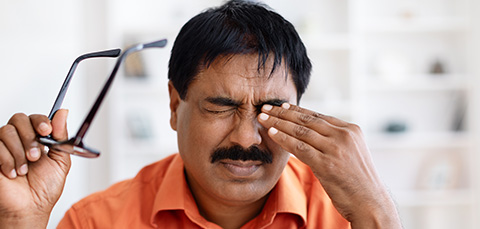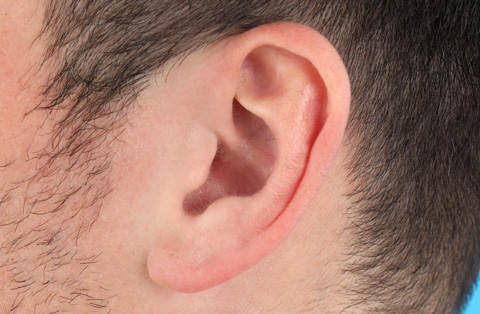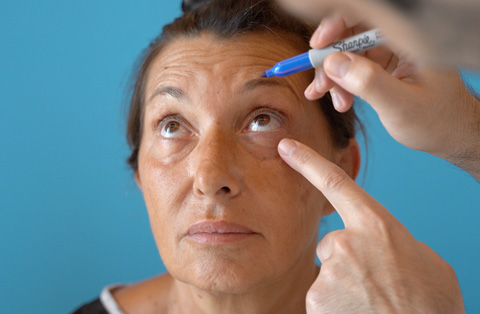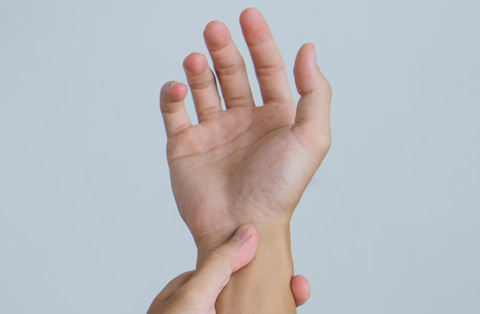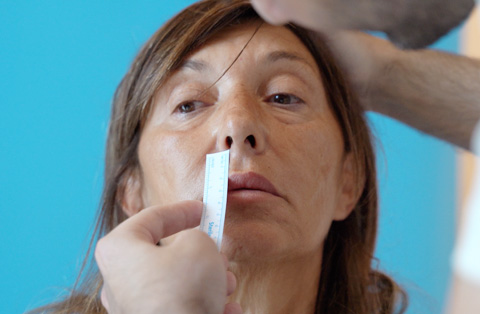Struggling with dry eyes and headaches? Discover how these conditions connect, what triggers them, and the treatments that bring lasting relief for clearer vision and less pain.
Dry eye syndrome is a condition where your eyes don’t produce enough quality tears, leading to irritation, burning, or blurred vision.
This matters because dry eye affects millions worldwide, and research shows it can intensify headaches or migraines by increasing eye strain and light sensitivity.
In this article, we’ll explain the connection between dry eyes and headaches, outline common symptoms and causes, and explore treatment and prevention strategies that bring real relief.
What is the Connection Between Dry Eyes and Headaches?
Dry eyes and headaches often occur together, but the connection is indirect. Dry eye syndrome does not directly cause headache, yet the discomfort it creates can trigger or worsen head pain.
When the eyes lack adequate lubrication, they become irritated, strained, and sensitive to light. Prolonged strain signals the nervous system, which may contribute to tension headaches or intensify existing migraines.
Another factor is shared triggers. Conditions such as screen overuse, dehydration, or poor sleep can aggravate both dry eye symptoms and headaches. In these cases, the two problems overlap rather than one singularly causing the other.
The key connection lies in the cycle of strain and discomfort: eye dryness increases stress on visual pathways, and this heightened strain can manifest as headache.
The Link Between Migraines and Dry Eye
Migraines and dry eye often overlap, and research suggests a two-way relationship. People with migraines are more likely to experience dry eye symptoms, while chronic eye dryness can make migraine pain more severe.
One explanation is nervous system sensitivity. Migraines involve heightened activity of pain pathways in the brain, especially those connected to the eyes. Dry eye irritation activates the same pathways, amplifying migraine intensity.
Light sensitivity is another shared feature. Both conditions increase sensitivity to visual stimuli, making screens, bright environments, or prolonged focus more likely to trigger pain.
Circulatory and inflammatory changes also play a role. Migraines can reduce tear production through altered nerve signals, while persistent dryness may promote surface inflammation that worsens migraine attacks.
In practice, the link means that patients with recurring migraines should be evaluated for dry eye, as treating one condition may lessen the burden of the other.
What are the Symptoms of Dry Eye Syndrome?
Dry eye syndrome produces a range of ocular symptoms that vary from mild irritation to persistent discomfort. The most common signs include:
Burning or stinging: A constant sensation of irritation in one or both eyes.
Redness: Blood vessels on the eye surface become more visible due to dryness.
Foreign body sensation: Many describe it as if sand or grit is in the eye.
Blurred vision: Visual clarity often worsens during reading or screen use.
Excessive tearing: Ironically, eyes may water as a reflex response to dryness.
Sensitivity to light (photophobia): Bright light intensifies discomfort in dry eyes.
Difficulty with contact lenses: Lenses feel less comfortable and may worsen irritation.
These symptoms often worsen in dry environments, with prolonged digital screen use, or at the end of the day. Recognizing them early helps reduce eye strain and may lower the risk of headache or migraine aggravation.
How to Identify Dry Eye and Headache Connection?
Identifying whether headaches relate to dry eye starts with tracking symptoms. People often notice that head pain appears after periods of visual strain, such as working on screens, reading, or driving. If headaches improve when eye discomfort is treated, this suggests a connection.
Look for overlapping signs: burning, gritty, or watery eyes combined with tension around the temples or forehead. Sensitivity to light that worsens both eye irritation and headache is another key clue.
Time of day also matters. Headaches that develop in the late afternoon or evening, when eyes are driest, often point to dryness as a contributing factor.
Keeping a symptom diary helps clarify the relationship. Noting when eye irritation, blurred vision, and headaches occur together can reveal patterns that support a shared cause.
If uncertainty remains, an eye examination can confirm dryness and exclude other eye conditions that may also trigger headaches.
What are the Treatment Options of Dry Eyes and Headaches?
Managing dry eyes and headaches requires a combined approach, since both conditions can influence each other. Treatment focuses on relieving eye dryness, reducing headache triggers, and preventing flare-ups.
1. Lifestyle and Self-Care Measures
Screen breaks: Follow the 20-20-20 rule—look 20 feet away for 20 seconds every 20 minutes to reduce strain.
Environmental adjustments: Use a humidifier, avoid direct air conditioning or heating, and wear wraparound glasses outdoors.
Hydration and diet: Drink enough water and include omega-3 fatty acids from fish or flaxseed to support tear film stability.
Sleep hygiene: Consistent sleep reduces both migraine frequency and dry eye discomfort.
2. Eye-Focused Treatments
Artificial tears: Over-the-counter lubricating drops provide temporary relief for dryness. Preservative-free options are best for frequent use.
Prescription eye drops: Anti-inflammatory drops such as cyclosporine or lifitegrast help restore tear production in chronic cases.
Warm compresses and eyelid hygiene: These improve oil gland function, stabilizing the tear film and reducing irritation.
Punctal plugs: Tiny devices placed in the tear ducts slow tear drainage and increase moisture.
3. Headache and Migraine Management
Trigger avoidance: Identifying and reducing exposure to light, stress, or dietary triggers lowers migraine frequency.
Medication: Over-the-counter pain relievers help with occasional tension headaches, while triptans or preventive drugs may be prescribed for frequent migraines.
Blue-light filters: Glasses or screen filters decrease eye strain, which can reduce both dry eye irritation and headache onset.
4. Combined Care Approach
Because eye strain and headaches often reinforce each other, treating both together offers the best outcomes. For example, consistent use of artificial tears may lessen eye irritation, which in turn reduces the likelihood of tension headaches. Likewise, effective migraine control can improve tear production and reduce ocular sensitivity.
5. When to Seek Medical Help
Persistent or severe symptoms should be evaluated by both an ophthalmologist and a neurologist. Coordinated care ensures that underlying conditions are not overlooked and that treatment is tailored to the individual.
How to Prevent Dry Eyes and Headaches?
Prevention focuses on reducing strain, protecting the tear film, and avoiding common triggers that affect both eyes and head pain.
1. Adjust Screen Habits
Follow the 20-20-20 rule to rest the eyes regularly.
Keep screens slightly below eye level to reduce exposed ocular surface and dryness.
Use blue-light filters to lessen visual fatigue that may trigger headaches.
2. Create a Supportive Environment
Maintain indoor humidity with a humidifier, especially during heating or air conditioning use.
Avoid direct airflow from fans or car vents hitting the eyes.
Use sunglasses outdoors to shield against wind and bright light.
3. Support Eye and Nervous System Health
Stay hydrated throughout the day to support tear production.
Include omega-3 rich foods like salmon, chia seeds, or walnuts to stabilize the tear film.
Prioritize regular sleep, since poor sleep worsens both dryness and headache frequency.
4. Manage Triggers and Stress
Identify migraine triggers such as caffeine excess, skipped meals, or strong light exposure.
Practice stress reduction methods like breathing exercises, meditation, or gentle physical activity.
5. Schedule Routine Care
Periodic eye exams detect early signs of dry eye and allow for timely treatment.
Regular check-ins with a healthcare provider help track headache frequency and prevent escalation.
Frequently Asked Questions
How do I know if my headache is from my eyes?
Headaches linked to eye problems often come with visual strain, burning, or blurred vision that worsens after screen time or reading. Pain usually localizes around the forehead or behind the eyes. If headaches improve with rest, blinking, or using eye drops, eye-related dryness or strain is a likely factor.
Can dry eyes affect your brain?
Dry eyes don’t directly damage the brain, but persistent eye irritation activates pain pathways linked to the nervous system. This can increase sensitivity, contribute to tension headaches, or worsen migraines. In severe cases, the constant discomfort may affect focus, mood, and overall quality of life, creating indirect brain-related effects.
Can eye drops help headaches?
Eye drops don’t treat headaches directly, but they relieve dryness that often contributes to eye strain and tension pain. By improving lubrication, artificial tears reduce irritation, blurred vision, and light sensitivity. For people whose headaches are triggered by dry eye, consistent use of drops may lessen both discomfort and frequency.
What does a high eye pressure headache feel like?
A high eye pressure headache often feels like deep, throbbing pain behind the eyes or around the temples. It may come with blurred vision, halos around lights, or nausea. Unlike tension headaches, it doesn’t improve with rest. Sudden, severe pain can signal acute glaucoma and requires urgent medical attention.
Are dry eyes a symptom of a brain tumor?
Dry eyes are not a typical symptom of a brain tumor. Most cases result from tear film instability, aging, screen use, or eye surface disease. While brain tumors can cause neurological eye problems such as vision loss or double vision, they rarely present with isolated dry eye symptoms alone.
How do you relax an eye headache?
You can relax an eye headache by resting your eyes, applying a warm compress, and using artificial tears if dryness is present. Taking short breaks from screens, dimming bright lights, and gently massaging the temples may also help. If headaches persist despite these steps, professional evaluation is recommended.
